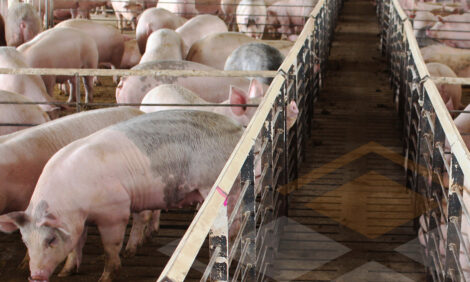



Pork Outlook Report - January 2004
By U.S.D.A., Economic Research Service - This article is an extract from the January 2004: Livestock, Dairy and Poultry Outlook Report, highlighting Global Pork Industry data. The report indicates that hog prices are steady and retail pork prices are slightly lower in 2004.
|
Retail Pork Price
Percent change from previous month 
|
Pork production in 2004 is expected to be slightly more than 20 billion pounds, an increase of less than 1 percent over 2003. Hog prices will likely average about $37-$40 per cwt. The depreciating dollar will push pork exports higher and slow imports in 2004. Some foreign markets currently closed to U.S. beef will likely substitute some U.S. pork products, providing additional support to U.S. pork exports.
Quarterly Report Indicates More Pigs, More Sows Farrowing
|
Weekly Hog Slaughter
Percent change from last year 
|
Several aspects of the December report point to larger pork supplies in 2004. The beginning inventory estimate for the marketing year-- December 1 inventory of all hogs and pigs--was larger than expected. Moreover, this estimate stood out among the last three--revised--quarters of 2003 as the only one above a year earlier.
The December report also suggests that some quarterly farrowing numbers may be larger than earlier expected. The actual farrowings for the September-November pig crop--to be slaughtered next spring--was increased to 1 percent above 2002. The second reporting of farrowing intentions for December-February--to be slaughtered next summer--was increased to 1 percent above a year earlier, also.
2004 Pork Production Set
If producers follow through on their stated breeding intentions, and based on expectations for litter rates and imports from Canada, it is likely that more than 101 million hogs will be slaughtered in 2004. The largest slaughter on record--101.5 million head in 1999--produced 19.3 billion pounds of pork. If slaughter expectations are met this year, pork production should exceed 20 billion pounds because of higher expected weights. Both anticipated hog slaughter and pork production for the year will be less than 1 percent above 2003.
Hog Prices Steady, Retail Pork Prices Slightly Lower in 2004
Hog prices (National Base Cost, 51-52 percent Lean, Live equivalent) are expected to average $37-$40 per cwt in 2004, more than 2 percent below 2003. Strong beef demand--despite BSE induced closure of major U.S. beef export markets--is expected to provide some support to pork and hog prices again this year. Additional price support is anticipated from strong foreign demand for U.S. pork products as partial substitutes for U.S. beef. Retail pork prices will likely decline less than 1 percent from 2003 prices, in order to remain competitive with expected lower retail beef prices. For 2004 retail pork prices are expected to average $2.65 per pound.
U.S. Pork Trade Affected by Depreciated Dollar in 2004
The lower valued U.S. dollar is affecting U.S. pork trade, both exports and imports. Because the lower valued U.S. dollar makes U.S. pork products relatively cheaper than pork products of competing countries (i.e. Denmark and Canada) in foreign markets, U.S. pork exports are likely to increase more than 3 percent, to about 1.8 billion pounds in 2004. Part of the expected increase is also attributable to increased foreign demand for U.S. pork products in some Asian countries imposing temporary bans on importation of U.S. beef products due to the recent identification of a BSE infected cow in the State of Washington.
U.S. demand for imported pork products also appears to be affected by the depreciated U.S. dollar. Pork products imported into the United States tend to be more expensive when the U.S. dollar depreciates against foreign currencies. Currencies against which the U.S. dollar has depreciated include the Canadian dollar and the Danish krone, currencies of the countries that account for more than 80 percent of U.S. pork imports. Consequently, U.S. pork imports are still expected to increase, but by less than previously forecast. The United States is expected to import about 1.3 billion pounds of pork in 2004, an increase of more than 7 percent over 2003.
Links
For more information view the full Livestock, Dairy and Poultry Outlook - January 2004 (pdf)Source: Livestock, Dairy and Poultry Outlook - U.S. Department of Agriculture, Economic Research Service - January 2004






